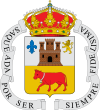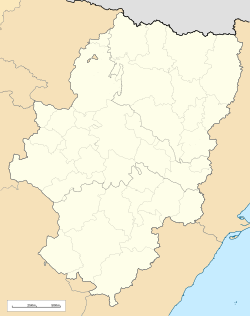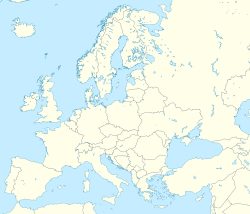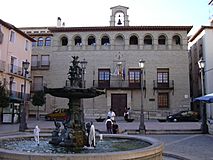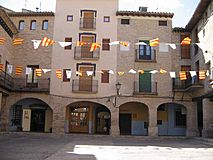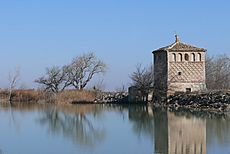Borja, Zaragoza facts for kids
Quick facts for kids
Borja
|
|||
|---|---|---|---|
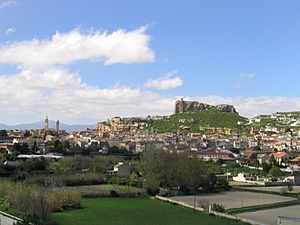
Borja in 2004
|
|||
|
|||
| Country | |||
| Autonomous community | |||
| Province | Zaragoza | ||
| Comarca | Campo de Borja | ||
| Area | |||
| • Total | 107 km2 (41 sq mi) | ||
| Elevation | 448 m (1,470 ft) | ||
| Population
(2018)
|
|||
| • Total | 4,922 | ||
| • Density | 46.00/km2 (119.1/sq mi) | ||
| Demonym(s) | Borjanos | ||
| Time zone | UTC+1 (CET) | ||
| • Summer (DST) | UTC+2 (CEST) | ||
| Postal code |
50540
|
||
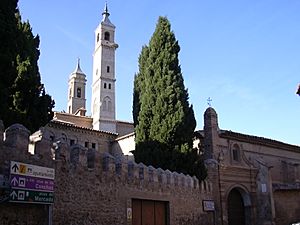
Borja is a town and municipality located in the province of Zaragoza. This province is part of the community of Aragon in northeastern Spain. In 2014, about 4,931 people lived there.
Contents
Geography of Borja
Borja is surrounded by several other towns and villages. These include Ablitas in Navarre, and many places in Zaragoza like Agón, Ainzón, and Tarazona. Borja is also the main administrative center for the area known as Campo de Borja.
History of Borja
Early History and Growth
The town of Borja has a very long history. Its story began around the fifth century BC. At that time, a Celtiberian settlement called Bursau or Bursao existed near where the old castle ruins are today.
After the Romans conquered the area in the first century BC, people also started living on the hillsides. However, the town really began to grow after the Muslim conquest in the eighth century AD.
Christian Rule and Fortifications
In the twelfth century, Christian forces from the north took control of Borja. During the 15th and 16th centuries, the town became a strong military fort. It helped protect the area from invasions by the Kingdom of Castile.
During this time, Borja also gained many of its beautiful old buildings. These include several churches and palaces. In 1438, King Alfonso V of Aragon officially gave Borja the title of "city."
The Borgia Family Connection
The famous House of Borgia family came from Borja. They became very important during the Italian Renaissance. Their name, "Borgia," is a different way of saying "Borja." When they lived in Borja, they were not yet famous, so not much is known about their early life there.
Challenges and Recovery
Borja faced a difficult period in the 17th and 18th centuries. There was an economic slowdown and outbreaks of diseases. The town started to recover economically in the 19th century. This was helped by a new railway that connected Borja to Cortes in Navarre.
In the 20th century, farming, which had always been very important to Borja's economy, became less so. Without many factories or industries, the town's importance in the region decreased. Many people moved away to find work in bigger, more developed areas. Today, there are plans to boost the industrial sector. New businesses are being encouraged to set up in the "Polígono Industrial Barbalanca," which is the Barbalanca Industrial Estate.
Population Changes in Borja
The chart below shows how the population of Borja has changed over the years.
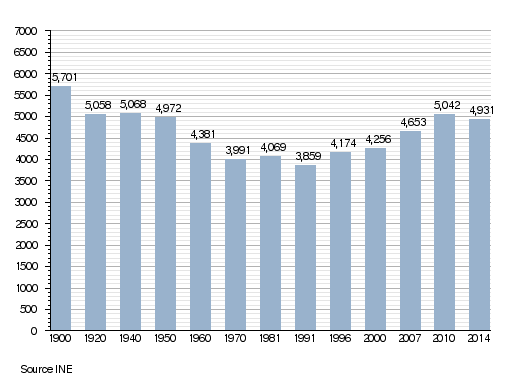
Main Sights in Borja
Borja has many interesting places to visit. Here are some of the main sights:
- Collegiate church of Santa Maria
- Church of San Miguel, which has a Gothic style with a Romanesque back part.
- Baroque convent of Santa Clara
- Hermitage of San Jorge, built in a Gothic-Mudéjar style
- The Town Hall, which was built in 1532
- A small temple from the 18th century
- A recently updated fresco of Christ
The Famous Fresco Restoration
In 2012, an elderly amateur painter named Cecilia Giménez tried to restore a fresco of Ecce Homo. This painting of Christ was made around 1930 by Elías García Martínez. The unique outcome of this restoration gained worldwide attention.
Even though the restoration looked very different from the original, it brought a lot of interest to Borja. Many tourists started visiting the town. In the year after the restoration, about 40,000 people visited. This brought in over €50,000 for a local charity. By 2016, the number of tourists had grown from 6,000 to 57,000. Visitors also spent money at local businesses and donated about €50,000 to the church. This money has helped hire more staff for the church and support a home for older people. On March 16, 2016, a special center was opened in Borja to explain the story of this artwork.
Notable People from Borja
Twin Towns
Borja has special friendly connections with two towns in France:
- Jurançon, France
- Lisle-sur-Tarn, France
Gallery
See also
 In Spanish: Borja (Zaragoza) para niños
In Spanish: Borja (Zaragoza) para niños



